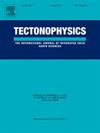3-D seismic delineation of the North Anatolian Fault System shear zone in the Western Half of Marmara Basin, Türkiye
IF 2.6
3区 地球科学
Q2 GEOCHEMISTRY & GEOPHYSICS
引用次数: 0
Abstract
We performed a 3-D AI-based structural interpretation of a seismic image volume derived from 3-D prestack time migration, and delineated fault geometries and the subsidiary Riedel shear fractures within the sedimentary overburden associated with the North Anatolian Fault System (NAFS) in the western half of Marmara Basin, Türkiye. We thus inferred existence of dextral strike-slip basement fault segments with extensional (releasing) and contractional (restraining) stepovers that gave rise to the formation of the geomorphic features --- the pull-apart Tekirdağ and Central Basins, and the Western High pop-up structure, respectively. The NAFS shear zone within the study area extends E-W and has a 20-km maximum N-S width. Previous investigations based on 3-D inversion of gravity data over the Sea of Marmara and the surrounding region, and long-range E-W seismic refraction profiling across the basin infer that the Moho depth is as shallow as 24 km in the western half of Marmara Basin --- nearly 6 km shallower than the average regional depth of 30 km. The Moho uplift forms a fairly narrow ridge (<30 km) confined to the NAFS shear zone, coincident with the E-W principal strike direction of the NAFS. This implies that it may have been formed contemporaneously with the formation of the pull-apart basins which gave rise to crustal stretching within the stepovers, resulting in basin subsidence, crustal thinning, and Moho uplift. The segmentation in the NAFS and the E-W trending Moho ridge may have led to the formation of earthquake rupture barriers and weak zones in the brittle upper crust.
马尔马拉盆地西半部北安那托利亚断裂系统剪切带的三维地震圈定[j]
我们对三维预叠加时间迁移得到的地震图像集进行了基于人工智能的三维构造解释,并在图尔基耶马尔马拉盆地西半部与北安纳托利亚断层系统(NAFS)相关的沉积覆盖层中划分了断层几何图形和附属的里德尔剪切断裂。因此,我们推断存在着具有伸展(释放)和收缩(限制)阶跃的右旋走向滑动基底断层段,这些断层段分别形成了地貌特征--拉开的特基尔达盆地和中央盆地,以及西部高地隆起构造。研究区内的NAFS剪切带呈东西向延伸,南北最大宽度为20公里。之前的研究基于马尔马拉海及周边地区重力数据的三维反演,以及整个盆地的长距离东西向地震折射剖面推断,马尔马拉盆地西半部的莫霍深度最浅为 24 千米,比 30 千米的区域平均深度浅近 6 千米。莫霍隆起形成了一个相当狭窄的山脊(30 千米),局限于北大西洋褶皱带剪切区,与北大西洋褶皱带的东西向主走向相吻合。这意味着它可能是与拉裂盆地的形成同时形成的,拉裂盆地的形成导致了阶地内的地壳拉伸,造成盆地下沉、地壳变薄和莫霍隆起。NAFS 的分段和东西走向的莫霍海脊可能导致了地震断裂屏障和脆性上地壳薄弱区的形成。
本文章由计算机程序翻译,如有差异,请以英文原文为准。
求助全文
约1分钟内获得全文
求助全文
来源期刊

Tectonophysics
地学-地球化学与地球物理
CiteScore
4.90
自引率
6.90%
发文量
300
审稿时长
6 months
期刊介绍:
The prime focus of Tectonophysics will be high-impact original research and reviews in the fields of kinematics, structure, composition, and dynamics of the solid arth at all scales. Tectonophysics particularly encourages submission of papers based on the integration of a multitude of geophysical, geological, geochemical, geodynamic, and geotectonic methods
 求助内容:
求助内容: 应助结果提醒方式:
应助结果提醒方式:


